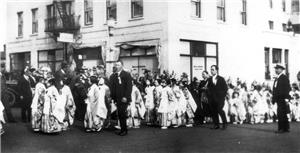On February 28, 1931, the Japanese American sangha (Buddhist community) of the Tacoma Buddhist Church begins three days of dedication ceremonies for its new building at 1717 S Fawcett Avenue in downtown Tacoma. Designed by architect G. W. Bullard (1856-1935), the permanent building several follows several location moves and is the result of intense fundraising efforts by the sangha. The sangha will change its name to Tacoma Buddhist Temple in 1983.
A Growing Congregation
Originally, the sangha had worshipped in several locations due to the lack of a permanent building. Services began in the back of Soroku Kuramoto's (1857-1929) general store in nearby Fife, just east of Tacoma, with Reverend Hoshin Fujii coming from Seattle each month. The sangha then rented a small room in Tacoma's Hiroshimaya Hotel in 1915. Members requested a fulltime minister from the Buddhist Mission of North America Headquarters and Reverend Danryo Modotani was assigned as the first official minister. Hyogo Nakashima, owner of the Hiroshimaya Hotel, was the church's first president.
With growing membership, the sangha raised money to rent a larger 1,000-square-foot meeting hall in Tacoma's Columbus Hotel in 1918. Before returning to Japan Reverend Yudo Komatsu, the church's minister from 1926 through 1928, urged the sangha to find money for a permanent building.
Fundraising and Construction
The next minister, Reverend Jokatsu Yukawa, was young with a dynamic personality. Under his leadership, a special meeting was held on August 1, 1929, and the sangha began to raise funds for a permanent site. Church Council President Masataka Fujimoto was appointed head of the fundraising drive.
Even in the face of economic hardship and racial discrimination, the sangha persevered. The stock market crash on October 29, 1929, left many members unable to fulfill their pledges. The building contractor refused to release the building title until full payment could be assured, and no banks would accept loan applications. A second fundraising drive for $6,000 ensued, and in less than two months, 25 church members came forward with the remaining funds. According to temple history, some members borrowed funds against their life insurance or homes. In just three months the sangha was able to raise the required $40,000 (more than $576,000 in 2018 value) for the building, an imported altar from Japan, the purchase of a parsonage house, and the cost of moving.
Groundbreaking ceremonies were held in January 1930 and construction began the following month. The parsonage house for Reverend Yukawa was part of the project and the sangha purchased a house, remodeled and painted it using volunteer labor, and moved it next to the church site for the minister and his family. A reporter from the Tacoma Daily Ledger marveled over the craftsmanship of the woodwork in the church building: "The rich scroll work and wood carvings over and about the platform, protecting the altar proper, were cut by Japanese Tacoma carpenters" ("Buddhists Open Temple ...").
Dedication Ceremonies
With the new church ready, dedication ceremonies began on February 28, 1931, and continued until March 2. The festivities included a parade from the first Tacoma site of worship in the "Red Room" of the Hiroshimaya Hotel to the newly completed church at 1717 Fawcett Avenue. Reverend Yukawa led the procession of the Ochigo ("celestial child"), a custom taken from Japanese nobility, along with 150 children of the sangha. After the children, local Bishop Kenju Masuyama walked with a statue of the Buddha. Following the bishop were Buddhist ministers from churches in Seattle, Portland, and White River. Close to 100 members of the Tacoma sangha marched after these dignitaries. Bishop Masuyama delivered a sermon. The parade ended in the Hondo (shrine) of the new building.
Because this was the first public procession of Japanese religion in the city, the parade attracted a great deal of local attention. Messages of congratulation from Japanese and Japanese American newspapers, including the Hokubei Jiji and the Daihoku-Nippon, were read aloud. A "dramatic presentation" on the basement stage downstairs at the church was also part of the festivities ("Buddhists Open Temple ...").
The forced mass incarceration of West Coast Japanese Americans closed the church during World War II, and few returned to Tacoma after the war. Nevertheless, the temple -- its official name was changed in 1983 from Tacoma Buddhist Hongwanji Church to Tacoma Buddhist Temple in consultation with its sangha -- continues to function as the last remaining institution from the city's prewar historic Japantown that still serves the Japanese American community.

